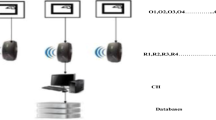Abstract
The security of public places has been greatly concerned by the government and organizations in recent decades. Detecting the crowd flow in public places can help alerting the congestion of the channel immediately and making an immediate evacuation policy to prevent the occurrence of extrusion stampede. However, the common detection techniques require special additional hardware components that suffer from too many factors. This paper proposed a method of crowd flow detecting based on RFID by analyzing the factors affecting the RFID link state. The system composed of the RFID tag arrays and the reader which detects the pedestrian flow according to the counts and the RSSI value of reading RFID tag arrays. With the evaluation in different scenarios, the coverage and moving status of the crowd can be verified.







Similar content being viewed by others
References
Benenson R, Omran M, Hosang J, Schiele B (2014) Ten years of pedestrian detection, what have we learned? Springer International Publishing, Berlin
Chang X, Yu YL, Yang Y, Xing EP (2017) Semantic pooling for complex event analysis in untrimmed videos. IEEE Trans Pattern Anal Mach Intell 39(8):1617–1632
Chang X, Ma Z, Li M, Yi Y, Xing AG (2017) Feature interaction augmented sparse learning for fast kinect motion detection. IEEE Trans Image Process 26(8):3911–3920
Chang X, Ma Z, Yi Y, Zeng Z, Hauptmann AG (2017) Bi-level semantic representation analysis for multimedia event detection. IEEE Trans Cybern 47(5):1180–1197
Gupta BB, Agrawal DP, Yamaguchi S (2016) Handbook of research on modern cryptographic solutions for computer and cyber security
Hurney P, Waldron P, Morgan F, Jones E, Glavin M (2015) Review of pedestrian detection techniques in automotive far-infrared video. IET Intell Transp Syst 9(8):824–832
Leibe B, Seemann E, Schiele B (2005) Pedestrian detection in crowded scenes. Cvpr 1:878–885
Li J, Yu C, Gupta BB et al (2017) Multimed Tools Appl. https://doi.org/10.1007/s11042-017-4452-0
Liu Q, Liang P, Zhou YS, Lao XL (2015) Pedestrian movement monitoring based on face recognition and rfid recognition. In: International conference on computer science and network technology, pp 673–676
Ortakci Y, Demiral E, Atila U, Karas IR (2015) Indoor navigation design integrated with smart phones and rfid devices, vol II-2/W2, pp 223–226
Schauer L, Werner M, Marcus P (2014) Estimating crowd densities and pedestrian flows using wi-fi and bluetooth. In: Accepted for the international conference on mobile and ubiquitous systems: computing, NETWORKING and services
Shi DY, Jian LU, Lin-Jun LU (2012) A judge model of the impact of lane closure incident on individual vehicles on freeways based on rfid technology and foa-grnn method. Journal of Wuhan University of Technology
Tewari A, Gupta BB (2017) Cryptanalysis of a novel ultra-lightweight mutual authentication protocol for iot devices using rfid tags. J Supercomput 73:1–18
Vishwakarma S, Agrawal A (2013) A survey on activity recognition and behavior understanding in video surveillance. Vis Comput 29(10):983–1009
Ye Y, Song C, Katsaggelos AK, Liu Y (2013) Wireless video surveillance: A survey. IEEE Access 1:646–660
Yu C, Li J, Li X et al (2017) Multimed Tools Appl. https://doi.org/10.1007/s11042-017-4637-6
Ziegler HG (2016) Privacy-preserving and iot-capable crowd analysis and detection of flow disturbances for enhancing public safety. In: Smartgreens: proceedings of the 5th international conference on smart cities and green Ict systems, pp 55–62
Acknowledgment
This research was supported by the NSF of China (Grant No.61673354, 61672474, 61402425, 61272470, 61305087, 61440060, 61501412), the Provincial Natural Science Foundation of Hubei (Grant No.2015CFA065).This paper has been subjected to Hubei Key Laboratory of Intelligent Geo-Information Processing, China University of Geosciences, Wuhan 430074, China. It was also supported by Open Research Project of The Hubei Key Laboratory of Intelligent Geo-Information Processing (KLIGIP201603 and KLIGIP201607).
Author information
Authors and Affiliations
Corresponding author
Rights and permissions
About this article
Cite this article
Fan, Y., Liang, Q. An improved method for detection of the pedestrian flow based on RFID. Multimed Tools Appl 77, 11425–11438 (2018). https://doi.org/10.1007/s11042-017-5303-8
Received:
Revised:
Accepted:
Published:
Issue Date:
DOI: https://doi.org/10.1007/s11042-017-5303-8




